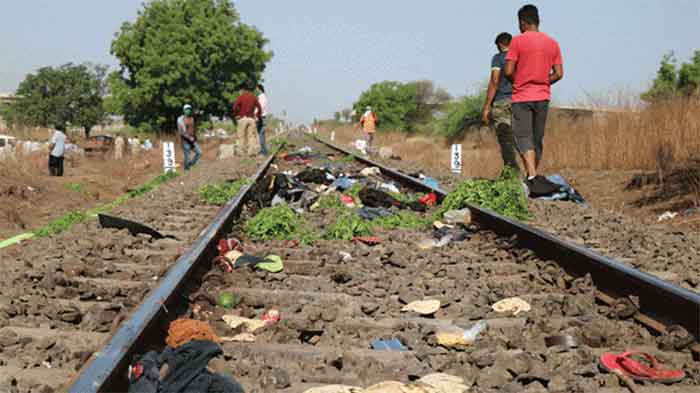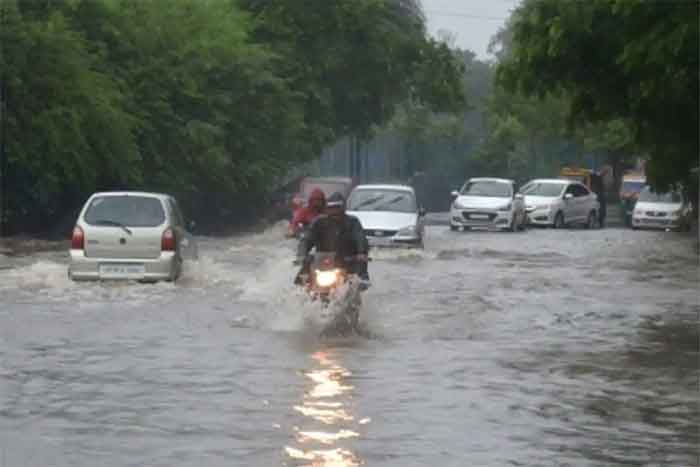
Even while a draconian lockdown was underway in late March 2020, and as thousands of migrant workers and their emaciated families escaped the pandemic in a helpless long march on miscellaneous highways, hungry and thirsty and holding tattered sacks as their only belongings, and even as the upper and middle classes in the affluent zones of Noida and Delhi, or, elsewhere, quickly withdrew into their online, comfort zones, the BJP regime declared an open war on human rights in India.
While it was expected that there would be a massive battle against the deadly virus on part of the central government, it, instead, chose to clamp down on constitutional, fundamental rights, in a manner perhaps unprecedented since the time of Indira Gandhi’s Emergency in India. The dark shadows of the deadly disease, and the darker shadow of State repression, started playing a macabre game, even as the streets became empty due to the lockdown, massive economic distress and mass phobia followed, and social isolation turned human beings into alienated, impersonal, detached and atomised creatures, hooked to their mobiles.
Meanwhile, the migrant workers kept walking, some dying on the way, in eternal sleep, crushed by a train as they walked along its tracks, their dry chapattis scattered all over; or, as, a mother, dead, lying on a sundry railway platform under the scorching sun in the Hindi heartland, her little child, pulling the aanchal of her saree. This was the achche din of the new India which many in old India had earlier welcomed with open hearts. Now, their hearts shut forever, they were banging on thalis and utensils in their balconies, to ‘scientifically’ fight a global pandemic, following the divine diktat of their Hindutva prophet.
Since the summer of 2014, a predictable pattern emerged in the continuous violation of human rights, under a new regime which came riding on a wave of right-wing pseudo-nationalism with the tall promise of India surpassing China in the days to come. The arrival of Covid, and the lockdown, only made it easy for the regime which had scant regard for basic freedoms and human rights, or, the constitutional ethics and ethos of the country’s freedom movement. This aggressive streak found a new haven as the streets became empty, and mass protests gave way to a passive stagnation across the urban zones.
 Jantar Mantar in Delhi became quiet. And, after a brave, stoic and resilient struggle by the mothers and daughters of Shaheen Bagh in Delhi, and the students of Jamia Millia Islamia, which was followed by huge, peaceful and protracted protests across the small towns and big cities of India, against the communal and polarising CAA, it all became as silent as death. Even as the deathly disease spread its fangs in the lanes and bylanes of Indian towns and villages, especially in the deadly summer of 2021.
Jantar Mantar in Delhi became quiet. And, after a brave, stoic and resilient struggle by the mothers and daughters of Shaheen Bagh in Delhi, and the students of Jamia Millia Islamia, which was followed by huge, peaceful and protracted protests across the small towns and big cities of India, against the communal and polarising CAA, it all became as silent as death. Even as the deathly disease spread its fangs in the lanes and bylanes of Indian towns and villages, especially in the deadly summer of 2021.
But, there was still hope. The great and glorious farmers’ struggle against the three pro-corporate lobby bills became a scaffolding for peacefully protecting the values of the Indian Constitution, and its secular, pluralist, democracy. The borders of the capital, fortified by the armed, repressive might of the Indian State, became non-violent barricades of a historic movement. Nothing like this was ever seen since the freedom movement against the British.
The assault on human rights might have been met with an opportunist and tactical silence by the middle and upper urban classes in their comfort zones in India, and large parts of the mainstream media, especially the television channels might have chosen to sell its soul, but this phenomena in the so-called largest democracy was noticed across the world, including in the West. Both the western media, various democratic governments, think-tanks and citizens collectives started noticing this dark phase in contemporary Indian history. The farmers’ struggle galvanised public opinion across the globe, including in the western media and power establishments.
The Varieties of Democracy (V-Dem) Institute, based in Sweden, stated categorically, much to the dismay of the Indian regime in Delhi: “The world’s largest democracy has turned into an electoral autocracy.”
The V-Dem report was scathing:
“Narendra Modi led the BJP to victory in India’s 2014 elections and most of the decline occurred following BJP’s victory and their promotion of a Hindu-nationalist agenda… The Indian government, rarely, if ever, used to exercise censorship as evidenced by its score of 3.5 out of 4 before Modi became prime minister. By 2020, this score is close to 1.5, meaning that censorship efforts are becoming routine and no longer even restricted to sensitive (to the government) issues… The Modi-led government in India has used laws on sedition, defamation, and counterterrorism to silence critics. For example, over 7,000 people have been charged with sedition after the BJP assumed power and most of the accused are critics of the ruling party.”
The America-based Freedom House report declared:
The national government and some state governments used assembly bans, internet blackouts, and live ammunition between December 2019 and March 2020 to quell widespread protests against the CAA and proposals to roll out a citizens’ registration process across the country.”
Predictably, the Indian government’s response was clichéd. It retaliated by countering that the Freedom House report is “misleading, incorrect and misplaced”.
Meanwhile, the TIME magazine, in its annual issue in September 2020, listed the 100 most influential people in the world, and chose to honour the gutsy Dadi of Shaheen Bagh: Bilkis Bano. She had become a cult figure of sorts with her viral interviews and gutsy public positions. However, TIME’s Karl Vick had this to say on the Indian prime minister:
“Though almost all of India’s prime ministers have come from the nearly 80 percent of the population that is Hindu, only Modi has governed as if no one else matters… First elected on a populist promise of empowerment, his Hindu-nationalist Bharatiya Janata Party rejected not only elitism but also pluralism, specifically targeting India’s Muslims. The crucible of the pandemic became a pretence for stifling dissent. And the world’s most vibrant democracy fell deeper into shadow.”
Like several similar repressive laws, the Unlawful Activities Prevention Act (UAPA) was originally enacted by a Congress government. Since then, it has been a handy tool in the hands of investigative agencies toeing the line of undemocratic regimes.
Michelle Bachelet, the UN High Commissioner for Human Rights, demanded the restoration of human rights and the release of all those charged under this draconian law, languishing in prisons for months on what are supposed to be cooked up charges. Covid gave the prisoners no respite, despite the Supreme Court seeking the release of undertrials on bail.
The Union government stated that as many as 3,974 people were arrested under UAPA between 2016 and 2018. Almost 75 per cent of the accused had no charges pressed against them. These were the official statistics as presented in the Lok Sabha.
In 2020, students from Jamia Millia Islamia (JMI), Aligarh Muslim University (AMU), and Jawaharlal Nehru University (JNU) were randomly picked up. Acclaimed young academics like Safoora Zargar, pregnant at that time, Devangana Kalita, Natasha Narwal, Gulfisha Fatima, Meeran Haider, Sharjeel Imam, Asif Iqbal, Umar Khalid, Shifa-ur-Rehman – President of the Alumni Association of Jamia Millia Islamia University (AAJMI), social activists Khalid Saifi and Ishrat Jahan, among others, were arrested under UAPA – the latter recently released on bail. They were falsely accused of instigating violence during the peaceful anti-CAA protests. Indeed, all they did, and they did it openly, is to invoke the values of the freedom struggle, and the ideals and principles enshrined in the Indian Constitution scripted by Babasaheb Ambedkar.
Earlier, several eminent writers, intellectuals and human rights workers were picked up, on what are again perceived to be fake cases based on the Bhima Koregaon issue. They included Stan Swamy, 80 plus, severely ailing, suffering from Parkinson’s disease and Covid, who died in prison. Among others arrested were Sudha Bhardwaj, Anand Teltumbde and Hany Babu. Since then, Sudha Bhardwaj has been released. Among the students, Natasha Narwal, Devangana Kalita and Sarfoora Zargar have been released. Others continue to languish in jail, in what seems to be a punishment preordained even before they are found guilty by any court of law.
Amit Sengupta is Executive Editor, Hardnews and a columnist, currently based in Kolkata












































